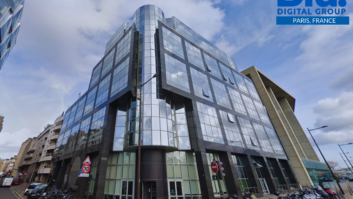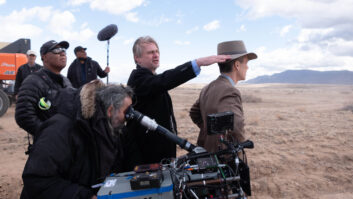This year saw the arrival of a new generation of Ultra High Definition 4K – and, other K — contenders in a Digital Cinematography market that may be maturing but is still seeing healthy growth and drawing more vendors. This has been reflected in this year’s edition of Digital Cinematography World 2014, published this spring, by D.I.S. Consulting Corporation of Woodstock, New York.
The study which gathered responses, worldwide, from more than 1,400 pros, covered 12 categories of hardware: Cameras, Camcorders, D-SLRs, Cinema Sound, Displays, Editing & Graphics Hardware, Lenses, Lighting, Production Switchers, Tripods, Recorders/Storage/Servers and Creative Software. The study, again, looked at four market segments: Production, Mobile/OB, Independent and Rental House, globally.
While the retirement of film has been substantially completed, thereby making it necessary for almost all films to be made using tape or hard drive recording, pushing the Hollywood community headlong into digital, the rental market continues to seek state-of-the-art gear in an almost unquenchable manner to enable it to have what producers want.
Meanwhile, the adoption of Digital Cinematography equipment and techniques by the freelance independent segment and by a legion of students is what has most helped the rapid expansion that has taken place. Plainly, a combination of their sheer numbers and the relatively inexpensive and highly accessible nature of the equipment has permitted a massive expansion of equipped producers and fed the coffers of the manufacturers. This has led to even more vendors offering kit.
From the known vendors, a number of new models were seen at the NAB Show this year. ARRI, Sony, JVC, Blackmagic and Red showed new products, some intended for the documentary making community. A number of new vendors introduced cameras and/or camcorders this year and made the choices wider and arguably more interesting for customers. AJA showed its Cion camera which was met with a good deal of excitement. Panasonic showed two models of its UHD technology.
Among the most appealing features most motivating cine camera, camcorder or D-SLR renters this year, according to the study’s rental house respondents were 1) cameras with 4K or other UHD sensors, 2) ability to use prime lenses, 3) a small footprint compatible with handheld shooting and 4) continued ability to shoot HDTV (or be switchable to that). Higher and variable frame rates are also beginning to attract more attention.
Continuing role of D-SLRs Although some cooling of the heretofore D-SLR frenzy can be felt, and this is underscored by a 20% decline in consumer D-SLR purchases this year, the use of the systems remains strong among movie makers and in episodic TV producers. That is reinforced by HD quality D-SLRs role as the de facto standard among students and independent professionals.
Growing sales, however, are seen coming from demand for UHD grade (ostensibly all 4K) D-SLRs, as they are seen more and more as what is needed if you are to shoot directly for motion picture uses. One drawback of D-SLRs is their relatively short segment recording capacity. But, that is largely overcome by the common use of outboard third-party recording and storage devices.
Countering that trend is a strong interest in mirror-less SLR systems that while allowing for interchangeable lens use, do away with the mirror shutter common to D-SLRs. That these systems are also priced lower does not go unnoticed by customers. It is possible that these competing features may find themselves blended in future generations of D-SLR design.
3D getting sidelined, even in movies While it is true that there continue to be 3D productions occurring in Hollywood and abroad, the excitement has been greatly reduced and just as in previous generations of the use of the technique, and there have been more than a dozen before, the enthusiasm for it has waned. Instead, the use of and focus on UHD is rapidly increasing.
What 3D equipment vendors were hoping for was a take up of the technology for episodic TV, sports specials and to spice up live events. That dream was rudely interrupted by networks cancelling specialist 3D channels and lacklustre consumer demand for that programming or for the TV sets themselves. This has also called into question most hopes for a 3D aftermarket.
While the greatest activity seems to be within the ranks of camera or D-SLR vendors, there are many components that go into what makes a UHD production. And, all of those component vendors are seeing benefits from the continuing revolution in cinematic production.
Seeing a good deal of activity is a range of storage devices for recording and maintaining footage from raw to compressed levels and through the post workflow. Among the leaders there are AJA and Blackmagic.
But, additionally, servers have seen a bounce from cinematic post production use. A variety of brands of pro audio see active use in recording sound in the field, editing it or sweetening it in post. Cinematic lighting continues to see changes as LED dominates that segment, even in truck-carried and studio uses and lower light capable imaging has scaled back the need for the intensity that previously characterised movie lighting. As cameras have been getting so much lighter and more compact and D-SLRs have proliferated the tripods and other support gear have followed becoming smaller, lighter and less costly.
Where vendors had hoped for UHD excitement to expand into broadcast TV and general video production, that has remained slow to happen so far. But, what is sure is that virtually all of the movie making and episodic TV community will be using UHD soon and HD use will be diminishing among those users, as UHD builds.





